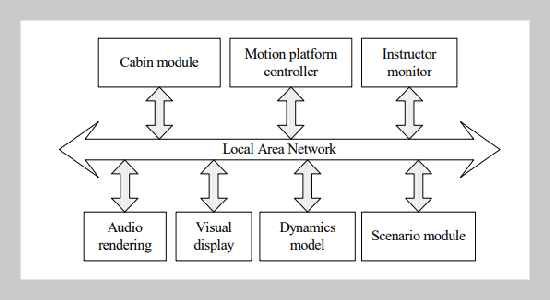REFERENCES
- [1] Bailey, R. W., Human Performance Engineering: A Guide for System Designers, Englewood Cliffs, N. J., U.S.A. : Prentice-Hall (1982).
- [2] Carraro, G. U., Cortes, M., Edmark, J. T. and Ensor, J. R., “The Peloton Bicycling Simulator,” Proceedings of the Third Symposium on Virtual Reality Modeling Language, Monterey, California, U.S.A., pp. 63-70 (1998).
- [3] Chandy, K. and Misra, J., “Asynchronous Distributed Simulation via a Sequence of Parallel Computations,” CACM, Vol. 24, pp. 198-206 (1981).
- [4] “Direct 3D Overview,” Available at http://www.microsoft.com/directx/overview/d 3d/.
- [5] Fadlallah, G., Lavoie, M. and Dessaint, L. A. , “Parallel Computing Environments and Methods,” International Conference on Parallel Computing in Electrical Engineering (PARELEC), Trois-Rivieres, Que., Canada, pp. 2-7 (2000).
- [6] Ferrazzin, D., Salsedo, F. and Bergamasco, M., “The MORIS Simulator,” 8th IEEE International Workshop on Robot and Human Interaction (RO-MAN '99), Pisa, Italy, pp. 135-141 (1999).
- [7] Greenberg, J. A. and Park, T. J., “Driving Simulation at Ford,” Automotive Engineering, pp. 37-40 (1994).
- [8] Huang, J. Y., et al., “Extension of RTI to Construct a Simulator over Distributed PCs,” 1997 Spring Simulation Interoperability Workshop, Orlando, FL, U.S.A., pp. 201-206 (1997).
- [9] Huang, J. Y. and Bai, H. H., “The Synchronization Algorithm for Constructing CAVE System on the PC Cluster,” The Seventh International Conference on Distributed Multimedia Systems (DMS'2001), Tamsui, Taiwan, pp. 135-141 (2001).
- [10] Kuhl, J., et al., “The IOWA Driving Simulator: An Immersive Research Environment,” IEEE Computer, Vol. 28, pp. 35-41 (1995).
- [11] Kwon, D. S., et. al., “KAIST Interactive Bicycle Simulator,” IEEE International Conference on Robotics and Automation (ICRA), Seoul, South Korea, pp. 2313-2318 (2001).
- [12] Lee, W. S., Kim, J. H. and Cho, J. H., “A Driving Simulator as a Virtual Reality Tool,” 1998 IEEE International Conference on Robotics and Automation, Leuven, Belgium, pp. 71-76 (1998).
- [13] Lin, C. T., Chung, I. F., Liann, S. A., and Su, F. Y., “Multipurpose Virtual-RealityBased Motion Simulator,” Proceedings of the 3rd World Congress on Intelligent Control and Automation, Vol. 4, pp. 2699-2704 (2000).
- [14] Menendez, R. G., Bernard, J. E., “Flight Simulation in Synthetic Environments,” IEEE 19th Proceedings of Digital Avionics Systems Conferences, Philadelphia, PA, U.S.A., pp. 2A5/1-2A5/6 (2000).
- [15] Moore, M. and J. Wilhelms, J., “Collision Detection and Response for Computer Animation,” Proceedings of the 15th Annual Conference on Computer Graphics, Atlanta, Georgia, U.S.A., pp. 289-298 (1988).
- [16] Park, M. K. et al., “Development of the PNU Vehicle Driving Simulator and its Performance Evaluation,” IEEE International Conference on Robotics and Automation (ICRA), Seoul, South Korea, pp. 2325-2330 (2001).
- [17] PVM: Parallel Virtual Machine – http://www.netlib.org/pvm3/book/node1.html
- [18] Rajkumar, A. R. R., Prakash, H. and Kishore, B., “PARDISC: a cost effective model for parallel and distributed computing,” IEEE 3rd International Conference on High Performance Computing, Trivandrum, India, pp. 451-456 (1996).
- [19] Roman, M., “Flight Simulators: A Look at Linux in the Aerospace Training Industry,” Linux Journal, Vol. 1999 (1999). Available online at http://www.linuxjournal.com/.
- [20] Srinivasan, S. and Reynold, P., “Communications, data distribution and others goodies in the HLA performance model,” 1997 Spring Simulation Interoperability Workshop, Orlando, FL, U.S.A., pp. 329-338 (1997).
- [21] Tam, E. K., et al., “A Low-Cost PC-Oriented Virtual Environment for Operator Training,” IEEE Transactions on Power Systems, Vol. 13, pp. 829-835 (1998).
- [22] Tanenbaum, A. S., Operating systems: Design and Implementation, Prentice Pub., ISBN 0-13-637406-9 (1987).
- [23] Taylor, V. E., Chen, J., Disz, T. L., Papka, M. E. and Stevens, R., “Interactive Virtual Reality in Simulations: Exploring Lag Time,” IEEE Computational Science and Engineering, Vol. 3, pp. 46-54 (1996).
- [24] The Message Passing Interface (MPI) standard - http://www-unix.mcs.anl.gov/mpi/.
- [25] Yoneda, M., Arai, F., Fukuda, T., Miyata, K., and Naito, T., “Operational Assistance for Straight-line Operation of Rough Terrain Crane,” IEEE International Conference on Systems, Man and Cybernetics (SMC'99), Sendai, Japan, pp. 27-32 (1999).
- [26] Zeltzer, D., Pioch, N. J. and Aviles, W. A., “Training the Officer of the Deck,” IEEE Computer Graphics and Applications, Vol. 15, pp. 6-9 (1995).
















